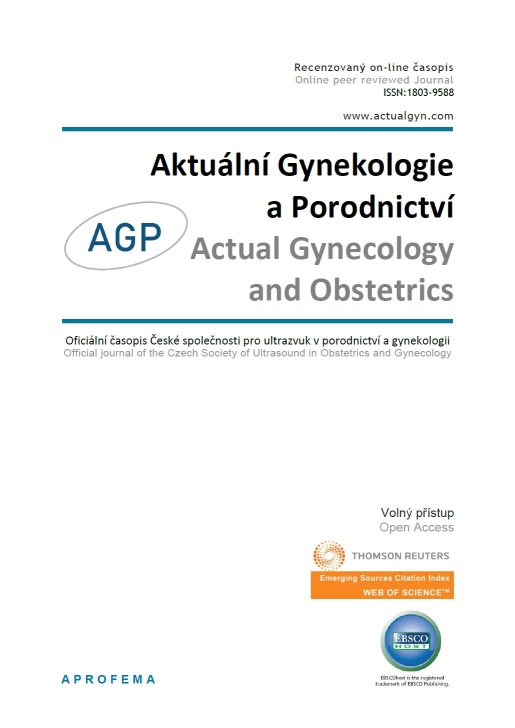











 Official publication of the Czech Society of Ultrasound in Obstetrics and Gynecology.
Official publication of the Czech Society of Ultrasound in Obstetrics and Gynecology.

Interim Guidelines The Czech Society for Ultrasound in Obstetrics and Gynecology CZMA JEP issued this opinion in connection with statements of the World Health Organization (WHO) and other international authorities about concerns regarding Zika virus infection. Concerns were expressed from the context of Zika virus infection with fetal microcephaly, which can be diagnosed on pregnancy ultrasound. At present exists uncertainty regarding both diagnostics and connection between Zika virus infection and impairment of the fetus. This opinion does not replace the recommendations and statements issued by state authorities such as the Ministry of Health and others, but solely deals with the possibility of prenatal diagnosis of fetal microcephaly and consultations of the pregnant women.
Pavel Calda, Miroslav Břešták, Antonín Šípek, Ladislav Machala
The Czech Society for Ultrasound in Obstetrics and Gynecology of the Czech Medical Association is issuing this statement in connection with statements from the World Health Organization (WHO) and other international authorities about concerns regarding Zika virus infection.
Concerns have been expressed regarding the connection between Zika virus infection and foetal microcephaly, which can be diagnosed during pregnancy solely by ultrasound.
At this moment, there is uncertainty regarding both the diagnostics and the connection between Zika virus infection and harm to the foetus. This statement is not intended to replace the recommendations and statements issued by governmental authorities such as the Ministry of Health, but deals solely with the possibilities of prenatal diagnosis of foetal microcephaly and the consultation of pregnant women.
The Zika virus is an arbovirus from the Flaviviridae transmitted by arthropods (dengue fever, West Nile virus and chikungunya). Over the past ten years the virus has spread from Polynesia to Easter Islands and further to Chile, Brazil, Columbia, Surinam, Central America, Mexico and the Caribbean. This RNA flavivirus is transmitted by the Aedes aegypti mosquito, with an incubation period of 3-12 days. The infection is asymptomatic in 75-80% of cases, with the rest of those infected only showing mild symptoms. The following symptoms may occur, individually or in combinations: high temperature, transient arthralgia and myalgia, maculopapular rash starting in the face and spreading to the entire body, mild conjunctivitis, headache and weakness (2). Similar symptoms are observed in a mild dengue or chikungunya virus infection. In some areas, such as French Polynesia and Brazil, the post-infection condition is accompanied by polyradiculoneuritis (the Guillain-Barre syndrome), a rare autoimmune disorder affecting the nervous system manifested by numbness of the limbs and impaired mobility. The symptoms of the disease are mostly mild and unspecific, typically last less than a week, and hospitalization is not required. Apart from mosquitoes, the virus can be transmitted by sexual intercourse, blood transfusion or vertically from a mother to her foetus during pregnancy and childbirth.
In Brazil, in areas with a high occurrence of Zika virus infection, anomalies of the central nervous system, namely microcephaly, have been reported, which have subsequently led to great concern regarding pregnant women who live in or travel to the affected areas. The Zika virus passes through the placenta and has been established by polymerase chain reaction (PCR) in the amniotic fluid of foetuses with microcephaly and cerebral anomalies; the virus has also been insolated post-mortem from the brain of foetuses with microcephaly. Yet, the connection between Zika virus infection and microcephaly in the prenatal period has not been conclusively proved.
To establish the link between maternal infection and intrauterine foetal anomalies, it must be demonstrated that the mother was infected; the infection was transmitted to the foetus; and that due to this specific infection the foetus was harmed. So far, none of these steps have been conclusively fulfilled for Zika infection. We do not know how many pregnant women exposed to the virus have actually become ill; in what percentage the infection was vertically transmitted from the infected woman to the foetus; and how many of the demonstrably infected foetuses developed malformations, in this case microcephaly. As for the assumed vertical transmission of the infection from the mother to the foetus, it is not clear at what stage (age) of pregnancy this may cause malformations in the foetus – whether only in the early stages of pregnancy or later.
Diagnosis of the infection is possible by direct detection of the virus by PCR. The PCR test from blood is only positive during the maximum viremia, which lasts for 5-7 days after the onset of the disease; for 1-2 weeks after the acute infection, presence of the virus can still be established by PCR in urine. Commonly used serological methods (detection of IgM and IgG antibodies using ELISA) are not in themselves sufficient, due to the possibility of cross-reactions in connection with other flavivirus infections or vaccinations, for instance against yellow fever or tick-born meningitis. Any positive result obtained by the ELISA method must therefore be confirmed by virus neutralization test (VTN), which can differentiate specific antibodies against the virus Zika from cross-reacting antibodies to other flaviviruses.
Ultrasound diagnosis is based on detecting foetal microcephaly in pregnant women with positive evidence of Zika virus infection.
The first step is reliable dating of the pregnancy using ultrasound biometry, ideally in the first trimester of pregnancy: a crown-rump length (CRL) before the 14th week of the pregnancy is the most reliable method of determining the actual age of the pregnancy. The menstrual age or the head circumference measurements in the second or third trimester of pregnancy can be very misleading and inaccurate.
Ultrasound examination to exclude microcephaly on suspicion of Zika virus infection should include:
1. In the first trimester (before the 14th week of gestation):
a) Crown-Rump Length (CRL), Biparietal Diameter (BPD) and Head Circumference (HC)
b) description of foetal morphology
2. In the second and third trimester:
a) BPD, HC, AC, femur length (FL), diameter of the lateral ventricles of the brain and transcerebellar diameter
b) description of foetal morphology
c) assessment of the presence of calcifications, periventricular and intraventricular echogenicity, symmetrical and regular shape of the lateral ventricles
Subsequent ultrasound examinations should be scheduled every 4-6 weeks, or at the discretion of the investigator based on the current findings.
In the presence of suspect or abnormal findings, the pregnant woman should be referred for consultation to a specialist. For this purpose, HC
Microcephaly, i.e. head below the lower threshold for the respective age, is a very rare disease in the Czech Republic, the isolated form of microcephaly being found exceptionally. During foetal life, microcephaly should only be diagnosed if the head circumference (HC) is below 3 SD for the relevant gestational age. Foetuses whose HC values were prenatally in the range of -2 to -3 SD showed no adverse neuropsychological development postnatally. Furthermore, there is a high probability that postnatal HC will be within the normal range.
For pregnant women with proven Zika virus infection where repeated measurements of foetal head circumference show growth retardation below 3 SD or where obvious brain anomalies are present, it is appropriate to exclude/confirm Zika virus or other viral agents in amniotic fluid by amniocentesis. Unfortunately, the sensitivity or specificity of this determination is not known. It is at the discretion of the investigator whether to recommend MRI examination of the foetal head which, in some cases, may indeed provide additional information. As some brain malformations may be part of complex genetic diseases and syndromes, it is appropriate to recommend genetic counselling, especially if signs of developmental defects of other organs are present as well as.
After birth, the prenatal efforts to determine, or confirm, the exact diagnosis will be continued by a neonatologist. Measurements of the newborn’s head must be carried out in a standard manner and compared against standards taking into account the gestational age at the time of birth and gender and ethnicity of the foetus. Increased monitoring of the child’s development by a pediatrician is recommended.
If Zika virus infection has been proved for the mother, it is recommended to test the umbilical blood for the presence of the virus and to provide histologic examination of the placenta.
So far, the Zika virus disease cannot be clearly linked to a disease of the foetus in utero, and the risk to pregnant women in Central Europe who do not travel to endemic areas is very small.
This standpoint will be continuously updated as new information become available.
Supported by the Ministry of Health of the Czech Republic – RVO VFN64165